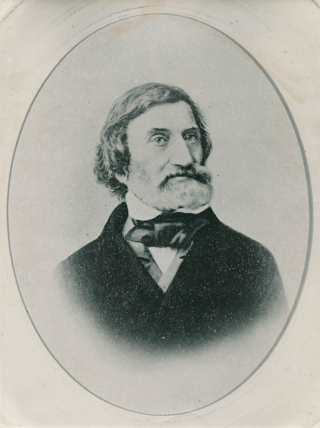Related Research Articles

Baron Sir Ferdinand Jacob Heinrich von Mueller, was a German-Australian physician, geographer, and most notably, a botanist. He was appointed government botanist for the then colony of Victoria (Australia) by Governor Charles La Trobe in 1853, and later director of the Royal Botanic Gardens, Melbourne. He also founded the National Herbarium of Victoria. He named many Australian plants.

Carl Ludwig Christian Rümker was a German astronomer.

Koncordie Amalie Dietrich was a German naturalist who was best known for her work in Australia from 1863 to 1872, collecting specimens for the Museum Godeffroy in Hamburg.

Johann Wilhelm Theodor Ludwig von Blandowski, known as William Blandowski, was a German explorer, soldier, zoologist and mining engineer of Polish descent, famous for his exploration of the Murray and Darling Rivers in Australia.

Otto Wilhelm Sonder was a German botanist and pharmacist.
Johann August Ludwig Preiss was a German-born British botanist and zoologist.
Karl Ludwig Philipp Zeyher, was a botanical and insect collector who collected extensively in South Africa. He was the author, with Christian Friedrich Ecklon, of Enumeratio Plantarum Africae Australis (1835-7), a descriptive catalogue of South African plants.

The National Herbarium of Victoria is one of Australia's earliest herbaria and the oldest scientific institution in Victoria. Its 1.5 million specimens of preserved plants, fungi and algae—collectively known as the State Botanical Collection of Victoria—comprise the largest herbarium collection in Australia and Oceania.

The flora of Western Australia comprises 10,551 published native vascular plant species and a further 1,131 unpublished species. They occur within 1,543 genera from 211 families; there are also 1,317 naturalised alien or invasive plant species more commonly known as weeds. There are an estimated 150,000 cryptogam species or nonvascular plants which include lichens, and fungi although only 1,786 species have been published, with 948 algae and 672 lichen the majority.
Karl Theodor Staiger was a German chemical analyst, naturalist and museum curator. Karl Theodor Staiger worked as a chemist for the Queensland Government 1873–80 and worked with Nicholas Miklouho-Maclay. He was secretary to the Queensland Museum from 1876 to 1879.
George Henry Frederick Ulrich FGS was a notable New Zealand mineralogist, university professor and director of the school of mines.

Diedrich Henne was a German-born botanist and plant collector. He emigrated to Australia and was employed as an assistant to the colonial botanist Ferdinand von Mueller at the Melbourne Herbarium.
Wendlandia psychotrioides is a species of shrubs or small trees, constituting part of the plant family Rubiaceae.

Friedrich Edouard Heinrich Wulf Krichauff was a politician in colonial South Australia.
Carl Walter, also known as Charles Walter, was an Australian botanist and photographer. He was born in Mecklenburg, Germany in about 1831 and arrived in Victoria in the 1850s.

Mary Harriet Bate was an Australian collector of botanical specimens for Australian botanists, especially the German-Australian Ferdinand von Mueller. Her contributions were recognised in the names of several species.

Robert J. Lendlmayer von Lendenfeld (1858-1913) was an Austrian zoologist, alpinist, and traveler. He was also a notable spongiologist.

Johann George Luehmann was an Australian botanist, who served as the Assistant Botanist and, later, as the Curator at the National Herbarium of Victoria, and who also, from 1896, served as the Government Botanist of Victoria.

Dr. Hermann Beckler was a German doctor with an interest in botany. He went to Australia to collect specimen for Ferdinand von Mueller and served as medical officer and botanist for the Victoria Exploring Expedition in 1860.

Clara Christine Maria Wehl was a German-born Australian botanist. She is known for her contributions to Australian botany through her scientific collections in Australia. The genus Wehlia and the species Gigartina wehliae are named in her honour.
References
- Barrett, L., Eckstein, L., Hurley, A.W. & Schwarz A. (2018), "Remembering German-Australian Colonial Entanglement: An Introduction", Postcolonial Studies, Vol.21, No.1, (January 2018), pp. 1–5. doi : 10.1080/13688790.2018.1443671